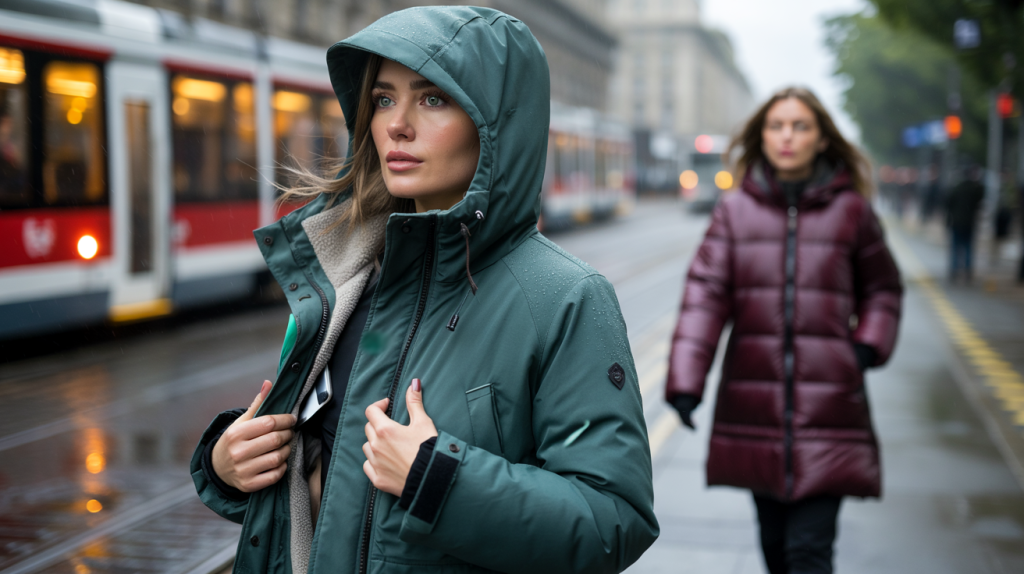Crack the code of the season’s must-have jacket under €220 : real warmth metrics, trusted labels, and a simple checklist to buy right now without regrets.
Cold hits, prices climb, and the hunt begins for that star winter jacket under €220. The goal is simple : stay warm, look sharp, and avoid paying for fluff. Good news : the best value this season sits in technical puffers and lined parkas that balance insulation, weather protection and cut.
Here is what shifts the decision fast. Warmth comes from measurable specs, not just trend photos. Think insulation weight, down fill power, water protection, and ethical labels. With those numbers in hand, a budget under €220 suddenly feels powerful, not limiting.
Women’s winter jacket under €220 : what matters right now
The main idea lands quickly : insulation quality beats logo power. A midweight synthetic puffer covers everyday commutes, while a lightly waterproof parka handles drizzle and wind. Length helps too. Hip to mid‑thigh cuts shield more of the body without feeling heavy.
Search interest agrees. Google Trends has shown repeated spikes each November and December for terms like “puffer jacket” in Europe since 2016, a sign that function‑first outerwear leads winter habits. That demand pushed high‑street options to get technical, not just trendy.
Real life set the tone as well. Winter 2019’s viral “Amazon Coat” moment, reported by The New York Times, proved that practical, multi‑pocket puffers can captivate beyond luxury names. Useful details still win hearts.
Warmth tested : down fill, synthetic grams, and waterproof ratings
Numbers remove guesswork. For down, fill power tells you how efficiently it traps heat. REI Co‑op’s expert advice explains that 600‑fill and above is solid for everyday cold, while higher fill means more warmth for the weight.
Synthetic insulation lists grams per square meter. Common urban‑winter sweet spots sit between 80 and 150 g/m², again referenced in REI Co‑op guides. Lower grams feel lighter, higher grams feel toastier. That is the trade‑off.
Water protection also has a scale. A 5,000 to 10,000 mm waterproof rating is typically described by REI as suited to light to moderate rain, especially with taped key seams and a snug hood. In cities, that is often enough when paired with an umbrella or scarf.
One more fact anchors the fabric debate. The European Environment Agency highlighted in 2019 that synthetic fibers account for around 60 percent of global clothing. Translation : plenty of affordable puffers use polyester shells and synthetic fill, so quality differences lie in construction and lining, not just fiber type.
Ethics and durability : labels to trust on a budget
Ethical sourcing is not reserved for luxury. The Responsible Down Standard was launched in 2014 by Textile Exchange to track animal welfare in the down supply chain. Seeing “RDS” on a hangtag helps when comparing two similar jackets.
For general safety, OEKO‑TEX Standard 100 has tested textiles for harmful substances since 1992. This label appears on many mid‑price shells and linings. It does not judge durability, but it does address unwanted chemicals.
Construction still matters. Double‑stitched baffles, storm flaps over zippers, soft fleece at the chin, and elastic or Velcro at cuffs keep heat in. When these details show up under €220, value jumps.
Smart shopping plan under €220 : where value hides
Here is the practical path. Start from climate, not color. If days are wet and windy, prioritize a water‑resistant parka with a hood. If air is dry but freezing, a puffer with stronger insulation wins. Fit a mid‑layer underneath during the try‑on. If shoulders pull, size up.
Sales cycles help, but sizes go fast. Late November and early January typically bring markdowns. That said, a well‑specced jacket at full price under €220 often beats a poorly built one at half off. Warmth per euro is the metric to chase.
Before heading to checkout, this simple checklist prevents regrets.
- Insulation : down at 600‑fill or higher, or synthetic between 80–150 g/m² for daily winter use, as outlined by REI Co‑op.
- Weather shield : 5,000–10,000 mm rating for regular rain, plus covered zippers and a fitted hood.
- Length : hip for agility, mid‑thigh for extra warmth while waiting for the bus.
- Labels : “RDS” for down ethics and “OEKO‑TEX Standard 100” for chemical testing, with launch years 2014 and 1992 respectively.
- Build : snug cuffs, chin guard, interior pocket for phone, and baffle stitching that feels secure, not flimsy.
- Care : machine wash cold, gentle spin, low heat tumble with dryer balls for down to re‑loft. Follow the care tag to avoid clumping.
That covers the essentials. Style still counts, yes, but comfort on a windy platform at 7:45 a.m. counts more. A matte shell reads polished at the office, while a slight sheen looks sportier on weekends. Either way, the right specs serve every outfit underneath.
One last step ties the plan together. Read the product page carefully, not just reviews. If specs are missing, ask customer service. Brands that invest in materials usually publish them clearly. If answers never arrive or sound vague, skip and move on. Time to adress the cold on your terms.
Sources : REI Co‑op Expert Advice on insulation and waterproof ratings ; European Environment Agency 2019 report on synthetic fibers ; Textile Exchange on the Responsible Down Standard 2014 ; OEKO‑TEX Standard 100 overview ; The New York Times coverage of the 2019 “Amazon Coat”.
